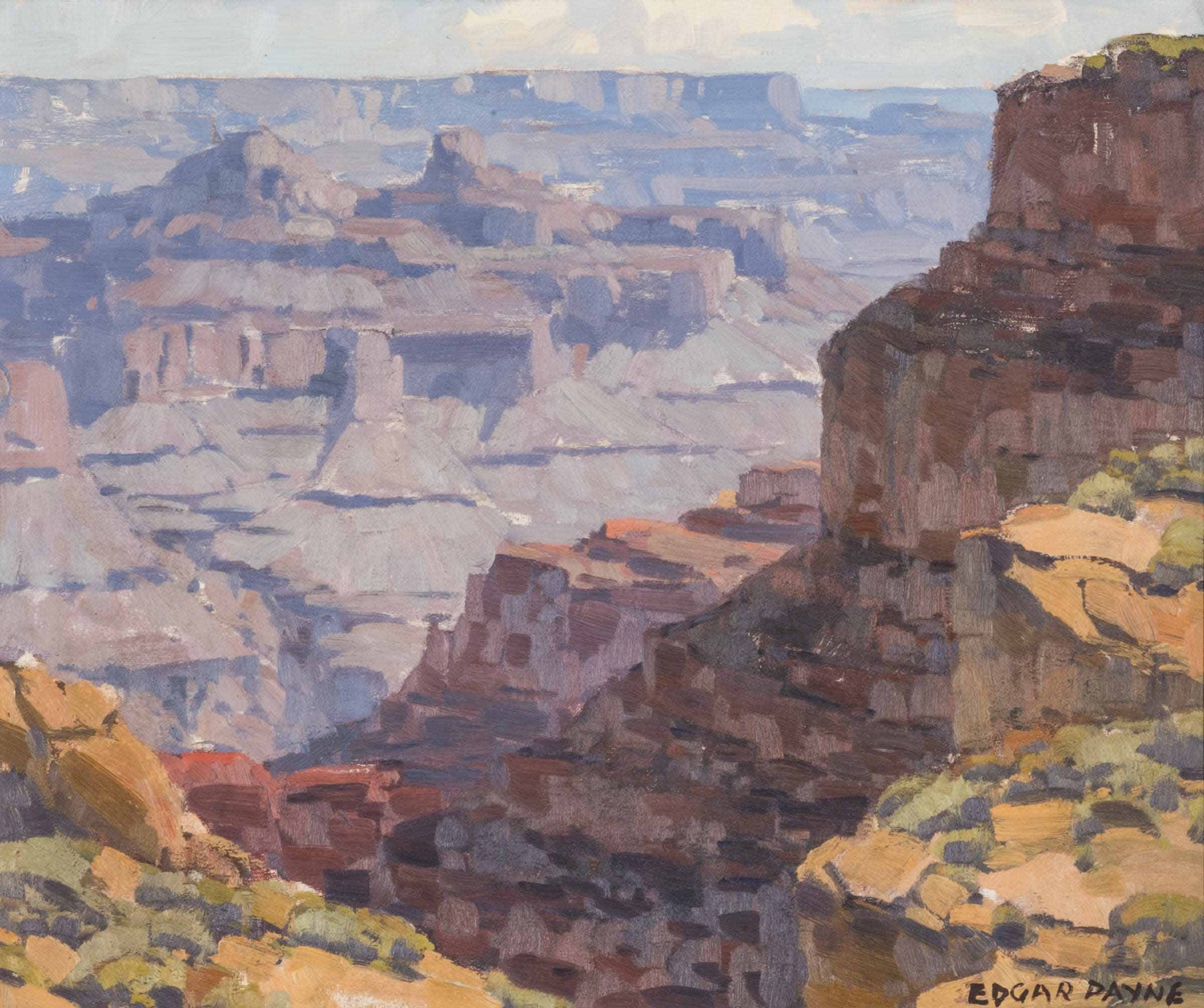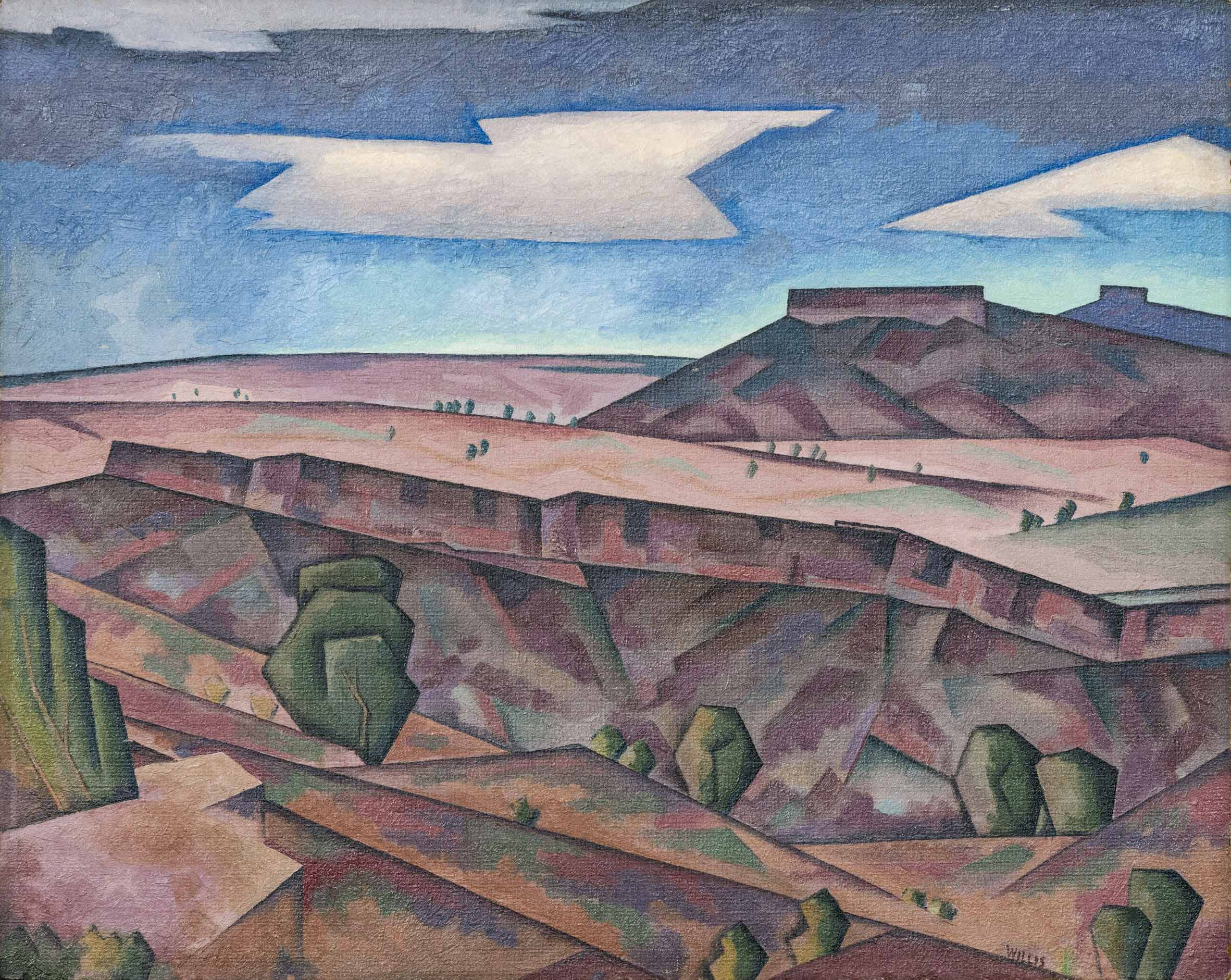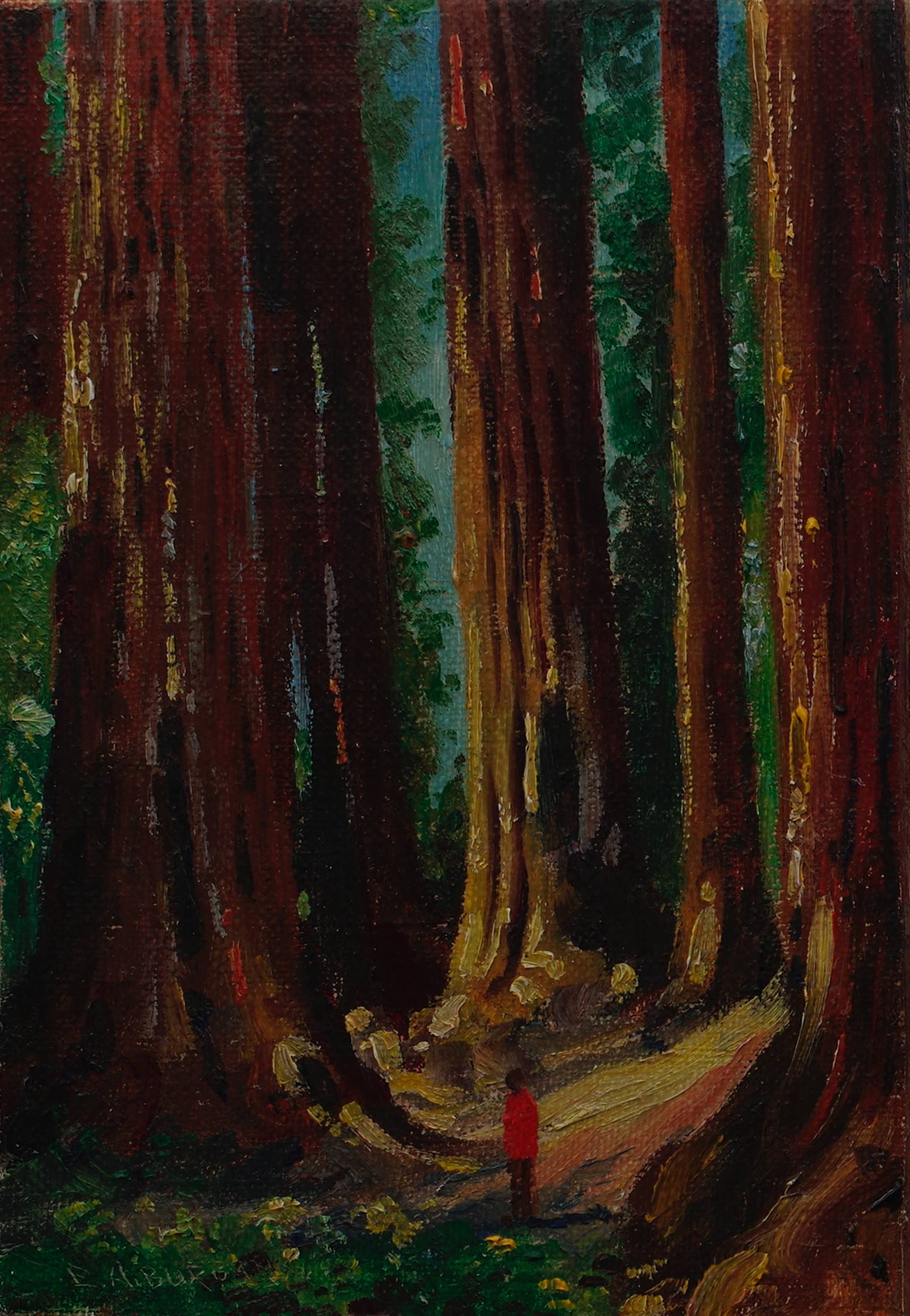Home » Special Exhibits » Views on the Southwest » The Lure of Landscape
Views on the Southwest
The Lure of Landscape
The distinctive Southwestern landscape has long inspired Western American artists. For many, its striking geography, vast skies, earthen palette, and pastel lighting beguiled and enchanted. The landscape was a principal subject for several artists whose works are part of Gallup’s New Deal art collection. Some highlighted its unique features through the exaggeration or abstraction of colors and forms, while others took a more traditional approach.
Read More
Many artists omitted any trace of contemporary life in order to heighten a sense of the desert’s beauty and isolation, despite the region having been home to Indigenous people for thousands of years, the site of Spanish colonization for several centuries, and more heavily trafficked by American settlers, transplants and tourists in the preceding decades. For some artists and urban collectors, such imagery represented a fantasy of a “pre-modern” world that was theirs to visually consume.2 In this sense, such landscapes evoke (consciously or unconsciously) the ideologies of Manifest Destiny, though the detrimental impacts of a white culture in Native lands often remain outside the frame in Western American painting. As Diné artist, archaeologist, and anthropologist Kevin Brown explains, the tendency of Western American art to picture a “pristine” or “untouched” landscape “erases Indigenous and Hispanic presence,” reinforcing “settler-colonial policy and a nationalistic perspective of consolidating geographic regions into the American identity.”
- As you explore the landscape paintings of Gallup’s New Deal art collection, are there any places that you recognize?
- Does a scene look like it does in real life, or has the artist’s imagination been at work?
- What or whom has the artist left out of the picture?
- Do any of these places mean something to you, your family, or your heritage?
Experiencing the Landscape
Artist Edgar Alwin Payne does not merely show us the Southwest landscape . . . he helps us to imagine what it feels like to be there. In his how-to book Composition of Outdoor Painting (1941), Payne described his goal to share the “spiritual flow which encircles animate and inanimate nature—the rhythm of life and the universe” in his paintings and to convey “the bigness of the landscape.” These lofty and poetic (and, some would say, romantic) aims suggest the strength of his connection with nature, which he experienced firsthand on extensive sketching trips to New Mexico and Arizona, including Canyon de Chelly and the Grand Canyon, two of the most famed natural sites in the region.
Payne depicted such scenes during the very same era that nature- and culture-based tourism was taking off in the Southwest. Just as we selectively frame and crop people and things out of our photos today, Payne chose to exclude any hints of tourism that would have detracted from this idealized scene of untouched nature. It was during the New Deal era, too, that the Fred Harvey Company’s “Indian Detours” whisked sightseers from the railroad to “Harveycar” tours of Pueblo villages and more remote areas of nature than train travel afforded.
Step into the scene
Though the identity and location of “Mesa Redonia” are unclear, this painting is a prime example of Payne’s use of color and brushstroke to evoke his experience of being in the landscape.
Step into the scene with this audio track, which will guide you with a series of slow looking prompts.
Reflect
- Has the painting changed for you after spending some time with it?
- As you explored the painting with your eyes and imagination, what overall “mood” or effect did the painting have on you?
- Did looking closely at the painting raise any questions for you about it, about the artist, or about the landscape itself?
- How might the experience of viewing this painting be different for a tourist or traveler versus a person whose ancestors have called this land home for thousands of years?
Picturing Place: An Artistic Debate
Two Views
These two paintings represent two different approaches to painting the Southwest landscape. Spend a minute looking at each work.
- What do you see?
- How are the paintings similar? How are they different?
- Which landscape do you like the best? Why?
Which painting do you think best captures the feeling of being in the Southwest?
Click either thumbnail image to cast your vote
Two Visions
Why do these two landscapes look so different? A closer look at each artist and artwork offers up some clues.
Albert Lory Groll
Albert Lorey Groll’s Red Rocks (left) is in many ways a traditional approach to depicting the landscape, a nod to his training at the royal academies of Antwerp and Munich and time spent in London, where he would have been exposed to a long tradition of landscape painting. Groll’s scene follows many historic conventions: the rocks on either side of the picture create a sense of balance, a curving path leads our eye from the foreground to the middle ground (as do the tiny figures and wagon that travel the well-worn path), and the dark haze of the purple-blue mesa in the far distance creates a sense of depth.
However, the distinctive red rocks and billowing, cotton-candy clouds clearly mark the scene as the southwestern United States rather than Europe. Based in New York City, Groll spent many summers in Arizona and New Mexico painting desert scenes like this and received high praise from patrons and critics on the East Coast. He was elected to the Taos Society of Artists as an associate member in 1919, joining colleagues who had similar European training and who likewise took a relatively realistic approach to painting landscape and figures.
Brooks Willis
By contrast, Brooks Willis’s Desert (right) offers an almost kaleidoscopic view of the landscape. Sharp, jutting angles define the clouds, trees, and mesas, and patchy areas of colorful paint highlight the varying surfaces and shapes. This abstracted approach to depicting nature is perhaps due to Willis’s time in Paris, where he was exposed to the new and daring approaches of modernism—in particular, Cubism, whose fractured forms turned traditional painting on its head. Willis also taught alongside “Transcendental” painter Raymond Jonson at the University of New Mexico, Albuquerque, during the early 1940s, and this painting shares a similar visual language of vivid colors, bold lines, and abstract forms. Painting the landscape in this mode was not about depicting what an artist literally saw but, rather, a chance to experiment with and express new visions of the natural world.
Creative Range
Artists responded to the Southwest landscape in numerous ways, depending on their artistic training, personal creative vision, and choice of medium. Additionally, artists’ colonies and collectives arose in northern New Mexico during the first half of the 20th century, resulting in sometimes competing claims to a so-called uniquely American art (from a Euro-American art historical point of view).
Taos Society of Artists
The Taos Society of Artists (1915–1927) embraced relatively traditional methods of picturing people and places. Many of its members had formal training in European art academies and studios. Joseph Fleck and Albert Lorey Groll were two artists who had social and professional ties to, or were members of, the Taos Society.
Santa Fe Art Colony
The Santa Fe Art Colony broadly refers to the community of artists that formed in Santa Fe after World War I and beyond. Though not a formally organized group and without a manifesto declaring a single style or aim, many of these artists embraced modernist approaches to painting.
Los Cinco Pintores
Smaller, short-lived artist collectives within Santa Fe include Los Cinco Pintores (the “Five Painters,” 1921–1926), founded by five artists including Józef Bakoś. This experimental group vowed to “bring art to the people” and exhibited their works in schools, hospitals, and other public buildings, including the state penitentiary.
Landscape paintings in the Gallup New Deal art collection reflect these dynamic and differing creative approaches. Explore a variety of scenic views and learn more about the artists by clicking on individual images that catch your eye.













